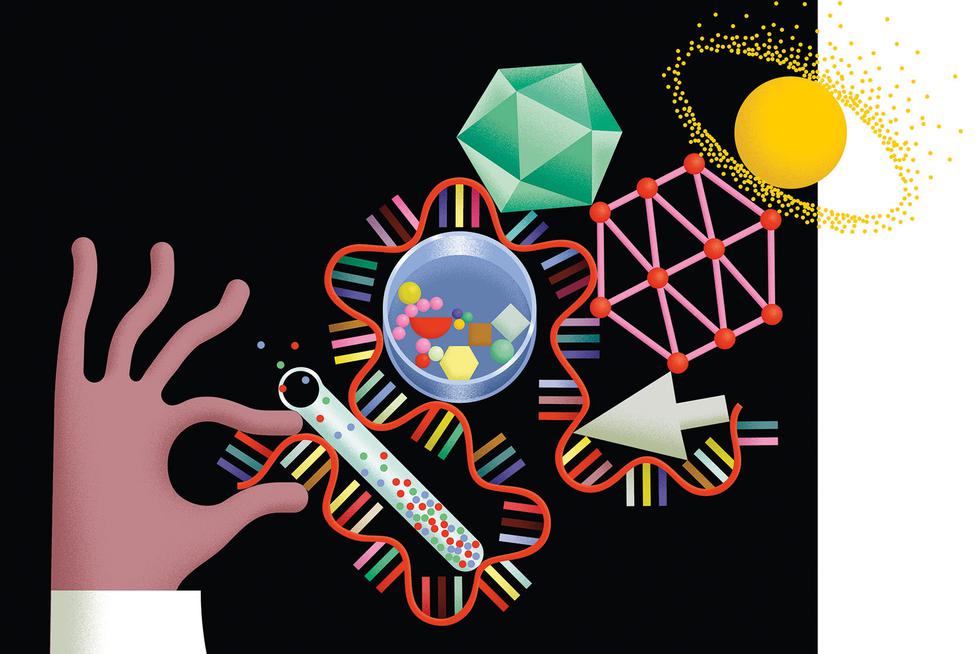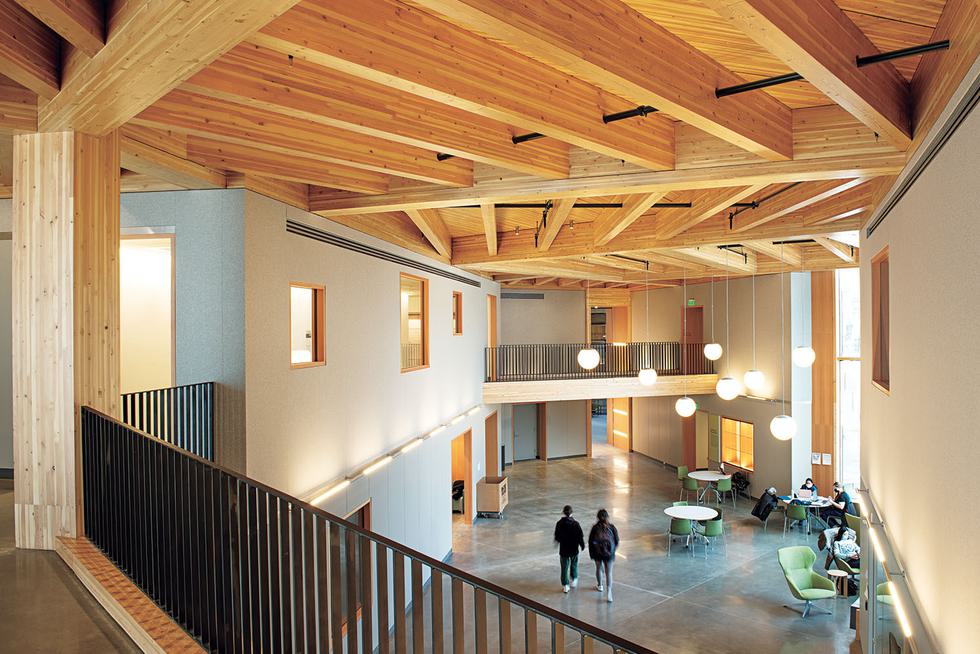Sarah Frances Whiting examines the bones in her hand using a fluoroscope in Wellesley’s physics laboratory in 1896. A Crookes tube is on the table in front of her.
The march of time and progress is inevitable, and that often means things get … discarded. Left behind. Forgotten. Or hastily shoved in a mislabeled box and left to sit unnoticed for decades.
Until, one night, the box is opened.
But before we get to that box, there were other boxes. And bits. And artifacts from years of teaching science at Wellesley. Items rescued from obscurity (and sometimes the dumpster) by John Cameron, now professor emeritus of biological sciences at Wellesley.
“Around 2012, 2013, I started to collect things,” he says. “My office and my lab started to look like a museum.” Long interested in the history of science, Cameron incorporated the origins of experiments and scientific ideas into his courses. “I became conscious of the fact that a lot of the artifacts that represented the ways in which biology in particular had been taught at Wellesley, objects that were used in laboratories, materials that were involved in teaching, were just being thrown away over the years.”
Cameron’s collection began to grow, and he and Kristina Niovi Jones, director of the Wellesley College Botanic Gardens, received funding from Science Center Director Cathy Summa ’83 to hire students to begin cataloging materials scattered throughout the Science Center. As the planned renovations for the building loomed, a committee was formed to help determine what to do with these items.
Wellesley’s physics laboratory, photographed here in 1893, was originally located in the fifth-floor attic of College Hall, which was destroyed in the fire of 1914.
Jacki Musacchio ’89, professor of art, was part of that committee along with Cameron. “The very fact that [these objects] survived—they’re incredibly rare, they’re beautiful, and in terms of their manufacture, they’re really interesting, so it was kind of a natural fit to do both science and art,” Musacchio says. In fact, the objects were the subject of a 2014 Davis Museum exhibit, The Art of Science, curated by Musacchio and art department colleagues Rebecca Bedell ’80 and Martha McNamara.
Work continued with the objects until “everything came to a head in 2019,” Cameron says. Sage Hall needed to be emptied ahead of construction, and so all of the artifacts needed a new home. “One night, like 9:30 at night, I was in the Science Center, packing up, and I found a box from the 1970s,” Cameron says. Although it was labeled as containing film, it held something unique. And historic. The box contained 15 cyanotype prints from some of the first X-ray experiments done in the U.S. (See four of the prints, with captions that were handwritten on the backs of the images, in the gallery below.)
German physicist Wilhelm Conrad Röntgen was the first to identify the rays, in November 1895, and he published his findings in German; news of his work reached English-language publications in early January 1896. Scientists across the U.S. quickly attempted to replicate and build upon his work. Sarah Frances Whiting, founder of the physics and astronomy departments at Wellesley, was one of them.
She successfully made an X-ray image on Feb. 7, 1896, using components available in Wellesley’s physics laboratory, pictured above.
Wellesley lore had Whiting as one of the first to replicate Röntgen’s experiments in the U.S., and that wasn’t far off the mark. “It turns out they’re not the first ones made in the United States,” Musacchio says. The first that can be corroborated happened on Jan. 27, 1896, at Yale, followed by several more done by men from large research universities. But “they were the first for an undergraduate institution almost certainly,” Musacchio says. “They were the first for women absolutely, and they have this great backstory, these women working together in a lab and putting their jewelry in a box to make an X-ray.”
Whiting, of course, did not do this work alone. She was assisted by physics instructor Mabel Augusta Chase, and at least two students: Annie Jump Cannon, class of 1884 (who had returned to Wellesley to take additional courses and went on to become a noted astronomer), and Grace Evangeline Davis, class of 1898 (who went on to become a noted meteorologist and teach physics at Wellesley). Involving students in experiments was part of the science curriculum at Wellesley, although that was not the case at most undergraduate institutions at the time. In fact, Wellesley had just the second undergraduate physics laboratory in the U.S. (after MIT), and the first undergraduate comparative anatomy laboratory in North America, Cameron says.
Of course, Cameron didn’t know all this when he first opened that box. “At that point, I was kind of jaded in terms of discovering something old,” he says, laughing. “The box was dated 1979, and I didn’t really expect anything to be in there. … It was quite a surprise.”
But he had an immediate sense of the images’ importance; he sent an email to Musacchio that night. That started their collaboration, delving deeper into the history of the photographs and what they signified. After months digging into archives, both at Wellesley and other institutions, the pair pieced together the history of these remarkable images and wrote an article detailing both the history of the X-ray experiments conducted by Whiting and the teaching of science at Wellesley.
“We’d been talking about doing something together for a while because we had these common interests in Wellesley history and in these amazing objects,” Musacchio says. “But we had so many objects to choose from. I think we probably could have written an article on any one of them.” But they say they found the Whiting images uniquely compelling. “Here we have a person who reads about something that happened, literally in the newspaper, and there’s a list of equipment, and she realizes that ‘Oh, my lab has that. Let’s try this,’” Cameron says. But that research led them to wonder, how did Whiting’s lab come to have that equipment on hand?
“In undergraduate laboratories, if they existed at all at that time, there was very little actual equipment,” Cameron says. But Wellesley was different. The College founders were invested in the idea of hands-on learning from the onset, and they funded and empowered professors to pursue that teaching method and whatever they needed to accomplish it. “At Wellesley, from the beginning, science courses had laboratories, and students were in those laboratories handling things,” Cameron says.
That interactive learning wasn’t constrained to just the sciences, however. “It goes across the College,” Musacchio says. In fact, the hands-on approach adopted by the art history department became known as the Wellesley method. “Wellesley was able to do that across disciplines, and that was what made the pedagogy here so different from other institutions, and enabled us to build up this great collection of equipment, because we needed it in order to teach,” she says.
Some of the equipment and artifacts will be on display in the new Science Complex so that students and visitors can learn more about the history of teaching science at Wellesley, as well as the history of the College itself.
Jennifer E. Garrett ’98 is a freelance writer and editor living in the Boston area. An English major at Wellesley, she was pleased to discover that the science laboratories she endured derived from a deeper historical purpose. To learn more about Whiting’s experiments, read Cameron and Musacchio’s article in Physics Today: bit.ly/PTWhiting.



Post a Comment
We ask that those who engage in Wellesley magazine's online community act with honesty, integrity, and respect. (Remember the honor code, alums?) We reserve the right to remove comments by impersonators or comments that are not civil and relevant to the subject at hand. By posting here, you are permitting Wellesley magazine to edit and republish your comment in all media. Please remember that all posts are public.